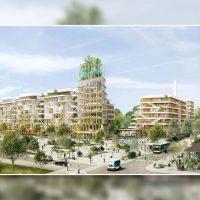 Europe’s largest timber-frame spec office complex secures funding
Europe’s largest timber-frame spec office complex secures funding
Trending
City approves mass timber, basement apartment rules
More than 7,000 building code amendments get go-ahead

The future of New York’s skyline is … timber?
Building with cross-laminated timber, a type of engineered wood consisting of glued-together panels of lumber, will soon be permitted in the five boroughs.
The City Council on Thursday approved extensive changes to the building code, which include allowing the special timber on projects up to 85 feet tall, or six to seven stories. While some buildings in the city have already used the material, they required extensive, separate approvals.
The change still leaves the city behind others in the U.S. and light years behind other countries in legalizing timber. In Canada, for one, dozens of such towers have already been built.
Read more
 Europe’s largest timber-frame spec office complex secures funding
Europe’s largest timber-frame spec office complex secures funding
Earlier this year, the International Code Council, a body whose recommendations are often used as guides for localities, approved the use of timber in buildings of up to 18 stories. Locations with booming timber industries, including Washington, Oregon, Utah, Idaho, Maine and California, have been quicker to adopt the recommendations, or versions of them.
Cross-laminated timber is billed as more sustainable than steel and concrete, and a means to cut down on construction timelines, given that it is prefabricated. It is still more expensive than traditional building materials, as standardization is lacking and few manufacturers supply it.
The City Council this week signed off on more than 7,000 revisions to the building code.
Another approved change reduces the minimum ceiling height of a basement apartment permitted in a two-family home to seven feet from eight. The amendment comes after about a dozen people drowned in basement apartments during an epic rain, renewing a debate over whether the city should further legalize basement apartments.
Mayor Bill de Blasio has promoted legalization as a way to create tens of thousands of affordable housing units. But the recent deaths have raised questions about such changes.
The code changes also include accelerated inspection timelines for elevators and periodic inspections of occupied buildings under construction, to ensure work complies with tenant protection plans.




